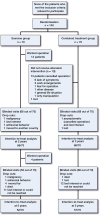Which patients do not recover from shoulder impingement syndrome, either with operative treatment or with nonoperative treatment?
- PMID: 25809315
- PMCID: PMC4750760
- DOI: 10.3109/17453674.2015.1033309
Which patients do not recover from shoulder impingement syndrome, either with operative treatment or with nonoperative treatment?
Abstract
Background and purpose: Shoulder impingement syndrome is common, but treatment is controversial. Arthroscopic acromioplasty is popular even though its efficacy is unknown. In this study, we analyzed stage-II shoulder impingement patients in subgroups to identify those who would benefit from the operation.
Patients and methods: In a previous randomized study, 140 patients were either treated with a supervised exercise program or with arthroscopic acromioplasty followed by a similar exercise program. The patients were followed up at 2 and 5 years after randomization. Self-reported pain was used as the primary outcome measure.
Results: Both treatment groups had less pain at 2 and 5 years, and this was similar in both groups. Duration of symptoms, marital status (single), long periods of sick leave, and lack of professional education appeared to increase the risk of persistent pain despite the treatment. Patients with impingement with radiological acromioclavicular (AC) joint degeneration also had more pain. The patients in the exercise group who later wanted operative treatment and had it did not get better after the operation.
Interpretation: The natural course probably plays a substantial role in the outcome. Based on our findings, it is difficult to recommend arthroscopic acromioplasty for any specific subgroup. Regarding operative treatment, however, a concomitant AC joint resection might be recommended if there are signs of AC joint degeneration. Even more challenging for the development of a treatment algorithm is the finding that patients who do not recover after nonoperative treatment should not be operated either.
Comment in
-
Is surgery for the subacromial pain syndrome ever indicated?Acta Orthop. 2015;86(6):639-40. doi: 10.3109/17453674.2015.1099597. Epub 2015 Oct 8. Acta Orthop. 2015. PMID: 26446801 Free PMC article. No abstract available.
References
-
- Bot SD, van der Waal JM, Terwee CB, van der Windt DA, Scholten RJ, Bouter LM, et al. . Predictors of outcome in neck and shoulder symptoms: a cohort study in general practice. Spine (Phila Pa 1976) 2005; 30(16): E459–70. - PubMed
-
- Brox JI, Gjengedal E, Uppheim G, Bohmer AS, Brevik JI, Ljunggren AE, et al. . Arthroscopic surgery versus supervised exercises in patients with rotator cuff disease (stage II impingement syndrome): a prospective, randomized, controlled study in 125 patients with a 2 1/2-year follow-up. J Shoulder Elbow Surg 1999; 8(2): 102–11. - PubMed
-
- Chaudhury S, Gwilym SE, Moser J, Carr AJ. Surgical options for patients with shoulder pain. Nat Rev Rheumatol 2010; 6(4): 217–26. - PubMed
-
- Davis AD, Kakar S, Moros C, Kaye EK, Schepsis AA, Voloshin I. Arthroscopic versus open acromioplasty: a meta-analysis. Am J Sports Med 2010; 38(3): 613–8. - PubMed
Publication types
MeSH terms
LinkOut - more resources
Full Text Sources
Other Literature Sources

